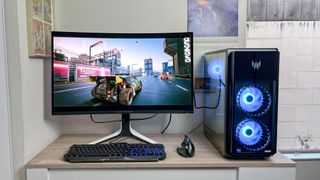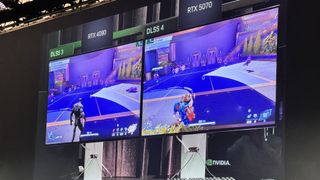
It’s happening once more.
This week, Nvidia launched its latest graphics card, the GeForce RTX 5070 Ti. As I covered the event live, I witnessed firsthand the complex dynamics of a modern Nvidia GPU release.
Although the current climate doesn’t seem as critical as when the Nvidia GeForce RTX 4000 series debuted back in 2022, or even with the launch of Nvidia’s 30-series in 2020, it still feels like a challenging time for those in the market for a new graphics card.
Scalpers are making it tricky to find the RTX 5070 Ti at fair prices, but it’s still easier compared to tracking down an RTX 5090 at its suggested retail price of $1,999.
I’ve noticed 5090s selling for as high as $4,500 on eBay, which is quite extravagant. If you have an extra five grand lying around, more power to you. For the rest, it’s best to hold off until availability improves and prices normalize.
My concern lies with the fact that people may get caught up in the hype and overpay due to the current price fluctuations. I’ve received numerous inquiries from friends and readers regarding the steep prices of these cards and whether investing in one is worthwhile, which makes me anxious that people may feel pressured to overextend themselves for the latest GPU.
I understand this feeling all too well. I famously grew frustrated during the GPU shortages in 2020, where it felt like Nvidia, Bitcoin miners, and the pandemic were all working together to keep the top-tier Nvidia cards exceptionally hard to find.

Having experienced this myself, I believe the current landscape of PC gaming is so excellent that the majority of us don’t actually require the potency of these new 50-series GPUs.
Recently, I was gaming on the RTX 4070 Super in our Acer Predator Orion 5000 review unit, where the experience with Cyberpunk 2077 in that setup compared to my Xbox Series X was significant. While I wouldn’t turn down a bit more power to reduce my reliance on DLSS, I feel content gaming on a 4070 for the next several years.
If you’re feeling pressured about purchasing a new Nvidia card this year, I want to assure you: there’s no necessity for a 5090 to enjoy the best PC games with solid framerates and have a great time. In fact, I don’t believe you need a 50-series card if you’re not eager for one. Here’s why.
More money and power does not always mean more fun

In essence, by managing your expectations below the level of the 5090, you can achieve considerable savings and enhance your peace of mind. The Nvidia GeForce RTX 5090 has an MSRP of $1,999 and demands a hefty 1000W power supply, but the price and power requirements diminish significantly as you move down the RTX 50-series lineup.
If you’re considering a 5090 but don’t have an extravagant budget, aim for an RTX 5070 Ti instead.
The 5080 is priced at $999 and requires 850W, while the 5070 Ti comes in at $749 with a 750W PSU requirement.
Therefore, for anyone eyeing a 5090 but not ready to splurge excessively, I recommend the RTX 5070 Ti as a more practical alternative. The power of the 5090 is remarkable, but it would be wasted if not matched with an equally powerful and pricey CPU, motherboard, monitor, and power supply.
Additionally, it’s hard to recall a time when PC games and ports were as well-optimized as they are today. Although some games still experience performance issues on PC—partly due to the necessity to accommodate a multitude of hardware configurations—major releases on Steam and ports from popular consoles generally run efficiently.
Given that the current consoles are now nearly five years old, the newest titles launching in the next few years are likely to perform excellently on a moderately specced gaming PC.
Thus, if you’re considering building a gaming PC this year but don’t want to spend over $1,000 on a graphics card, seeking out a solid deal on a used RTX 4070 Super, currently around $649, could be a savvy move.
Just be sure to confirm that any used GPU you’re considering has not been subjected to crypto mining, as that kind of use can severely impact the hardware’s longevity.
DLSS 4 is the real game-changer

Lastly, I’d like to emphasize that investing in the raw power of an Nvidia graphics card has become less critical, particularly with the advancements in DLSS (Deep Learning Super Sampling) upscaling technology.
Overall, I have come to appreciate DLSS, as it often determines whether a game is playable or nearly unplayable due to framerate issues.
While it may not have launched perfectly, DLSS has drastically improved over the years, and I now try to incorporate it into every game that offers support. Although some games yield mixed results or occasionally display graphical glitches, the overall enhancements provided by DLSS can be the difference between playable and frustrating framerates.
Importantly, it allows gamers to experience advanced features of Nvidia GPUs without a significant drop in frame rates.
For instance, I played a substantial portion of Cyberpunk 2077 on Xbox, but once I switched to PC playing with DLSS and path tracing enabled at 4K a solid 60 FPS, I couldn’t return to console gaming.
Even seemingly minor enhancements, such as realistic street reflections on the glass of a passing cop car, feel astonishing.
This was my experience last week on an RTX 4070 Super gaming PC from 2024, which you could purchase for less than the cost of one new RTX 5090 ($1,799 vs. $1,999).
Although Nvidia claims that the 40-series cards will not support the Multi-Frame Generation feature enabling the RTX 5070 to achieve higher framerates than the RTX 4090 in Marvel Rivals, I believe you can still enjoy gaming without it.
In fact, I’ve seen reports that some resourceful users have managed to adapt a version of Multi-Frame Generation to work on 40-series Nvidia cards. Since Nvidia has stated that all DLSS 4 features, except for Multi-Frame Generation, will be available for 40-series cards, it’s reasonable to speculate that these features could run smoothly on a 4070 or 4090.
The Bottom Line

If you’ve read this far, I hope it’s clear that I’m not attempting to detract from the excitement of building a high-performance gaming PC in 2025. If your sights are fixed on acquiring an RTX 5090, go for it.
However, if you harbor even a faint sense of anxiety or frustration reminiscent of past Nvidia card launches, I hope this offers some reassurance.
Nvidia is certainly enjoying a robust position in the market, largely fueled by its increased focus on AI in recent years. If that aspect doesn’t concern you, the experience of gaming with Nvidia graphics cards is at an all-time high.
If you’re uncertain about investing in an RTX 5090, take advice from someone fortunate enough to test all this hardware: while it’s impressive, it’s not the end-all. I frequently derive immense enjoyment from playing top Steam games on PCs that are two or three years old.
For my part, I believe the RTX 5070 Ti represents a far more sensible investment, and you might find that a quality 40-series card will serve you well for many years to come.
Where to buy RTX 5070 Ti (U.S.)
More from Tom’s Guide









